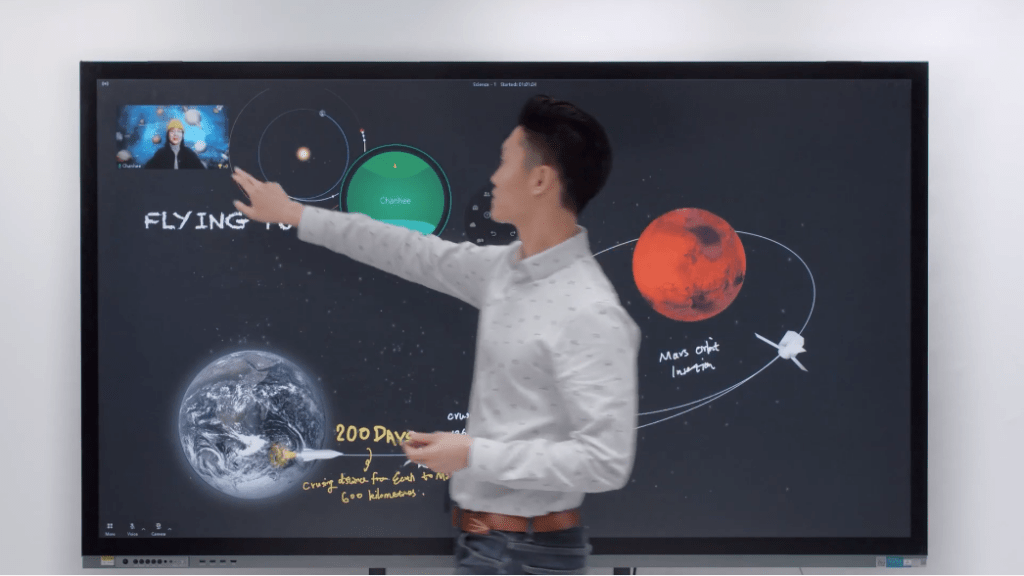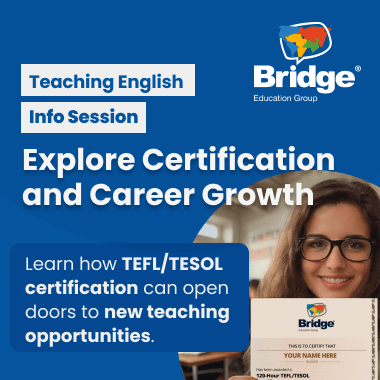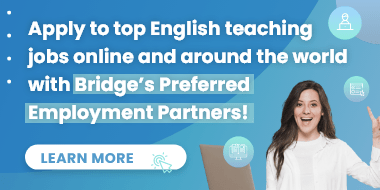Online instruction made its presence known in the world of education decades ago. However, mobile applications, originally purposed for productivity assistance, are now being used for more than just playing Candy Crush or Words with Friends. The educational technology, or EdTech, industry linked a few gems of their own and found that learning English online or through a mobile application, or app, can help children and adults learn languages.
Daniel Hutchinson is Cambridge University Press’ Global Learning Solutions Director in the English language teaching (ELT) division. As one of the giants in the education arena, Cambridge is a global learning and assessment organization in addition to being a publisher and an elite university. Hutchinson says he sees the English language teaching industry as a changeable picture that was accelerated by the pandemic.

“I think that whilst we would never have wanted the situation to be the backdrop, it could only be a good thing for people to be really thinking where education goes, where English education goes. That will lead to, I hope, lots of innovation, lots of debates, discussion and hopefully lots of positives coming out of that,” he says.
“There probably isn’t a teacher or a learner on the planet who hasn’t had a pretty tough couple of years and probably is going to continue to do so for a while. I think that the best thing we can do generally, and certainly as Cambridge, is to say, ‘let’s see what we can do with this situation and make it as effective as it can be when we come out the other side’. I think the future continues to be exciting. There are a lot of things to be positive about with education in general and English education as well. It’s one of the things that keeps me in my job: that hope and also belief that we can do that.”
And as Hutchinson can verify, the world of English language teaching (ELT) and English as a second language (ESL), is finding and evolving a virtual life of its own.
Mobile Learning: M-Learning Brings New Tools to Old Trades
“Using mobile apps in language learning is most efficient when combined with a blended learning approach where face-to-face instruction is combined with online learning.”
According to a 2020 study in the International Journal of TESOL Studies, the most difficult challenge ESL students in an intensive English program at Brigham Young University’s English Language Center found was schoolwork. Many identified problems using and adapting to technology-driven courses as the culprit, followed by the act of actually practicing English. Students found it nearly impossible to practice English by speaking with other students, and the opportunities to practice outside of the classroom were limited, especially during the pandemic.
In recent years, the world has seen an increase in the interest in mobile learning, or M-learning, primarily because of the mobility of the technology, learners and learning itself. Jaroslav Kacetl and Blanka Klímová examined the use of smartphones and English language learning and found that M-learning not only offers great opportunities but is becoming more widely accepted in education. They write, “The key features of M-learning, such as personalized learning, independent of time and place, collaboration with peers and teachers in both formal and informal settings, ubiquity and interactivity of mobile devices, make M-learning efficient.”
They add that using mobile apps in language learning is most efficient when combined with a blended learning approach where face-to-face instruction is combined with online learning. Blended learning, according to the authors, appears to be more effective than traditional instruction alone. M-learning also appears to be especially valuable in developing language skills, facilitating the retention of new vocabulary and motivating students with a fun and game-like way to learn.

Researchers Ramya Gangaiamaran and Madhumathi Pasupathi found that Mobile-Assisted Language Learning, or MALL, allows the learner to gain knowledge without the constraints of time or place. MALL is a combination of M-Learning and CALL, computer-assisted learning. “Equipping the learning apps can change the regular lecture classroom and students learning interest can increase,” they write. “Language skills like listening, speaking, reading, writing skills will be acquired by these learners. On the other hand, they will learn grammar, vocabulary and meanings, pronunciation, spellings and more on the part of language acquisition.” Additionally, the rapid development of app technology, in general, has made English learning apps able to incorporate a variety of media, such as text, pictures, animation, video, audio and more, to keep the student interested.
Now, nearly 5.3 billion people, or 66.92% of the world population, have mobile devices. Even in economically-challenged parts of the world, families own cell phones, creating a vast community of potential, tech-assisted language learners.
“Thanks to different media modes, students can remember 10% of what they have read, 20% of what they have heard, 30% of what they have seen, 50% of what they have heard and seen, 70% of what they have said, and 90% of what they have done.”
Not only is M-learning fun for students, but studies have shown that retention of vocabulary words increases with student use of apps for language learning. Blanka Klímová found in her review study of smartphones usage for English as a foreign language (EFL), that mobile devices help students in motivation, performance, interactivity, diversity of resources, collaboration, and autonomy of learning EFL, in addition to the personalization of language learning to an individualized level. “Thanks to different media modes, students can remember 10% of what they have read, 20% of what they have heard, 30% of what they have seen, 50% of what they have heard and seen, 70% of what they have said, and 90% of what they have done,” the study reports. With M-learning focused on the “doing,” students are able to retain more information.
Adding new technology into the educational sphere aids EFL students in learning a new language in an interactive, portable, self-regulated and individualized manner. It has also helped teachers provide engaging lessons while receiving individualized data about each of their students. While most learners are familiar with language-learning apps like Duolingo and Babbel, many other unique and innovative apps and online language education options exist. This is where companies like ClassIn, Off2Class and Studycat are bringing language learning to homes and classrooms around the world by providing support and education that benefits students, teachers and parents.
ClassIn Transforms the Online Classroom
“ClassIn complements it by including more than 20 teaching tools and a giant blackboard in the virtual classroom where you, as a teacher, can keep an eye on all students while initiating a variety of classroom activities with them.”
ClassIn, an “interactive online classroom” created solutions long before the pandemic even began by presenting online learning to the world in 2014. Today, ClassIn has more than 20 million users and is used in 60,000 institutions and schools across 150 countries.
Ivan Fen Qin, the Global Business Development Manager for ClassIn says, thanks to technology, ClassIn’s teachers have been able to conduct online classes with discussions, breakout rooms, debates, quizzes, polls and team presentations as if they are happening in an actual classroom.

“ClassIn was being built when online communication was not a huge thing,” Qin says. “Even today, many schools or other educational institutions still rely solely on video conferencing to deliver video lectures. From a pedagogical viewpoint, we think this is inadequate.”
Qin says video conferencing products fail in interaction because they allow for speaking and screen sharing only in momentary and limited timeframes.
“Every educator would agree upon the fact that interaction is the key to effective learning, and this particularly applies to younger learners. So ClassIn complements it by including more than 20 teaching tools and a giant blackboard in the virtual classroom where you, as a teacher, can keep an eye on all students while initiating a variety of classroom activities with them,” he says.
Another issue teachers face, Qin says, is the managerial aspect of creating links and academic calendars and sorting out materials between various systems. “ClassIn is a one-stop solution so our teachers don’t have to travel back and forth between maybe up to four different platforms. It can monitor our students’ behavior and has everything analyzed so the teacher will not get lost and will have a good understanding of his or her students,” he says.

Finding interactive, engaging ways to provide a holistic approach to learning also sets ClassIn apart, according to Qin. “I would argue that especially under current circumstances as a result of COVID-19, when academic activity happens online, your platform of choice better include all kinds of scenarios that you used to have in the physical classroom, such as presentations, group discussions, homework, assignments and exams.”
Qin says learning a new language is a difficult process to begin with, but with the help of educational technology, it can be beneficial, productive and interesting. “I personally speak English as a second language, and I will never forget how hard it was when I was a kid in school. So, I could not be able to imagine if I learned a language with some teacher in the United States through my computer when I was 6 years old,” he says. “It’s pretty much common sense that the online classroom has to be highly engaging and entertaining to keep our learners moving forward.”
To keep up with the latest technology, ClassIn developed a future classroom to assist online learning by making it more hybrid and interactive. ClassIn was designed solely as an online platform, but “the next generation of ClassIn, which is Called ClassIn X, solves this problem perfectly. ClassIn X works with hardware,” Qin says.
With ClassIn X, teachers in a classroom with a smartboard can open ClassIn, find their textbooks and materials on their own cloud drives, and begin to teach. “As there should be cameras, remote students can be joining from their homes and see what’s going on in the classroom and of course, vice versa. So that’s the future classroom we envision, and we call it OMO, namely Online-Merge-Offline,” he says. The OMO model combines hybrid infrastructure and open education practices, and merges online and offline learning and teaching spaces together.
Qin says the OMO model will help bridge the gap between in-person and online education. “To stress back to teaching English as a second language, I myself am an advocate of communicative language teaching, so I firmly believe in cultivating communicative competence for situations and activities, which go way beyond just listening and speaking to your computer,” he says. “In-person education gives you that human touch when online education allows you to get exposed to a way larger audience beyond geographic limits and, given that it’s digital, it’s smarter in collecting and analyzing our students’ learning process. This leads us back to the OMO method.”
This new period of e-learning has disrupted the conventional classroom and an approach to education that has been unchanged for generations. It is likely that the post-COVID world will have a new perception of the pros and cons of both online and offline education. “That is why I myself and ClassIn are very excited about ClassIn later this year.” Qin adds, “Improving the teaching and learning experience for our customers is everything we care about.”
Off2Class sends teachers into a virtual classroom equipped with tools for success
“It’s not a coursebook that has been rehashed as a web product. It takes over screen-based classrooms in ways that a PDF never could. What this does is create a more immersive experience for teachers and students.”
Kris Jagasia, the CEO and co-founder of Off2Class, also took an opportunity to recreate the 21st-century classroom. In 2014, while living in Istanbul teaching English, he and James Heywood founded Turkey’s first online ESL school. When building the school, they became frustrated with the materials and software that were available and created their own. Off2Class was born. The company offers a software toolkit, now used by thousands of teachers in more than 120 countries, to deliver online and in-classroom ESL lessons.
“Off2Class content has been built from the ground up for teaching on screens, so teachers do not have to adapt any further,” Jagasia says. “It’s not a coursebook that has been rehashed as a web product. It takes over screen-based classrooms in ways that a PDF never could. What this does is create a more immersive experience for teachers and students.”
Off2Class provides interactive ESL lessons with classroom materials, a step-by-step curriculum, homework assessments, placement tests and reports and data, as seen here.
“What’s incredible about Off2Class is that it functions in virtual and brick-and-mortar classrooms,” he says. “Since Off2Class is such a stellar example of a virtual tool kit, it is being utilized by Bridge Education Group to certify online ESL teachers. This is incredibly special because this is the first-ever practicum for teaching English online available, and we are so happy to be a part of this revolutionary training process.”
“Many products try to replace the role of teachers in the virtual classroom, whereas Off2Class works to enhance it by empowering teachers with support tools.”
Jagasia says the organization believes that teachers are essential to the language learning equation. “We are built around supporting teachers and enabling them to focus on their students,” he says. “Many products try to replace the role of teachers in the virtual classroom, whereas Off2Class works to enhance it by empowering teachers with support tools.”
The goal of Off2Class is to save teachers time and provide them with lesson content in a virtual setting. They can select from hundreds of lessons that cover grammar, reading, writing, speaking, listening and vocabulary. Task-based lessons cover students from beginner to advanced levels. Teachers are provided with reports and data for each student that not only helps the students but also assists in tracking teacher performance.
“My prediction is that the future of learning will rely on a hybrid model. With that being said, there needs to be a greater focus on providing teachers with content that works seamlessly in both physical and virtual environments,” Jagasia says. “I believe that teachers are the most important component in any learning equation, so they need to be given the tools to succeed in this hybrid environment.”

Jagasia says teachers must be the focus as many find it hard to unearth lessons that are adaptable for virtual classrooms while still maintaining student engagement and retention. “This gets all the more confusing when teachers are bombarded with expensive and underdeveloped resources from companies hoping to capitalize off the global crisis,” Jagasia says. His advice for teachers is: “Keep at it, keep it simple, find what works and use it. Don’t over-encumber yourself with all the new shiny tools and tricks.”
Jagasia says Off2Class wants to give back to teachers as much as possible and, as a result, the company gets a lot back from the teacher community. “One of our major endeavors during COVID has been to provide as many teachers as possible with free lesson plan downloads and free Off2Class accounts. We know how difficult it has been for teachers during this pandemic,” he says. In order to help, Off2Class provided more than 15,000 free accounts and more than 29,000 lesson downloads. Their Facebook group has grown from 1,500 to more than 6,500 members since March 2021. “When a teacher uses Off2Class, they are not just using a product, but joining a community of teachers that truly want one another to succeed.”
Maria Feist, an English to Speakers of Other Languages, or ESOL, specialist based in Downingtown, Pennsylvania, has been using Off2Class for her K-12 students for blended learning. She retired from the classroom but has entered the online teaching space and says she was relieved to have a well-organized and easy-to-implement program for her students. “The placement test was easy to administer, and it let me know what lessons my students needed. Having ready-made lessons that I could add to, if I wanted to, was a real lifesaver for me going back to school during the pandemic,” she says. “My students enjoyed the lessons. The ready-made homework assignments to go along with lessons were wonderful to have as well.”
Studycat ‘Hands Learning Back to the Person Who Wants to Learn’
Whiddon says the app-based world is interesting because learning occurs for a fraction of the cost. Studycat allows parents to know what their children are learning without paying for expensive language classes or tutors, and still have their kids learn a new language in an interactive manner.
Jake Whiddon is the Head of Learning Experience at Studycat, an interactive app-based technology company that offers language learning for children. Studycat is used in 80 countries, 1,000 schools and by 14 million families. Created by educators, the app offers English, Spanish, Chinese, French and German.
“Providing language learning for kids at home and with apps and integrating it into their lives as opposed to just the usual teacher at the front holding flashcards, that’s what attracted me to Studycat,” Whiddon says. “In the last three years I’ve been working for them, we’ve grown a lot. It’s the one place where we can be creative, push new ideas and challenge the usual ‘normal’ of learning languages.”

With Studycat, students learn language alongside a sweet, big-eyed cat surrounded by fun visuals on par with PBS Kids cartoons. Learning colors with Studycat’s “Fun English” is easy when you get to pick the color white out of a group of colors and paint the cute teddy bear, or pop all the purple balloons. Picking fruits by bursting all of the watermelons or matching the oranges in a matching game keeps children learning words while playing fun games.
“Usually, you see tech companies trying to go into education, but these guys are teachers who went into tech, and I think that works much better because they are actually thinking about learning as the outcome.”
Whiddon says the app-based world is interesting because learning occurs for a fraction of the cost. Studycat allows parents to know what their children are learning, without paying for expensive language classes or tutors, and still have their kids learn a new language in an interactive manner.
“We are proud to say our apps are 100 percent interactive,” Whiddon says. “Our point is if you are going to pay money and download this app, and we’ve only got you captured for 15 minutes, we want you doing something. So, we make sure our game play is always interactive. If you’re not touching the screen, I don’t really see any point in you using the screen. You might as well be watching it on a TV or using a textbook.”
Studycat initially started as a number of schools moved to the online format in the early 2000s. In 2010, they turned learning into a game-based app. In 2018, Studycat had another life, as a cat certainly should, and morphed into a schools-product for languages as well. “They are good guys who started it. Usually, you see tech companies trying to go into education, but these guys are teachers who went into tech, and I think that works much better because they are actually thinking about learning as the outcome,” Whiddon says.
“Data is the new language of the learners.”
Studycat is primarily for elementary-age students who want to learn a language, and there are two available products: one for individual consumers and one for schools. Whiddon says what distinguishes Studycat from other language-learning apps is the interactivity, engagement and challenge. The game scaffolds quickly to keep children at a challenging level that continues to motivate them. “Every touch on the device is a data point that we can feed back to our learning management system that the teachers and parents can use to see how well their child is doing,” he says. “We have accuracy on every single word that they are learning, so we can actually see that they saw this word nine times and seven times they were right, so we can use that.”
Whiddon says the “recycling” process of getting the students to come back while the data is made available to teachers and parents is what truly sets Studycat apart. It allows the teachers to look at their whole class and determine how each individual student is doing and what topics the teacher needs to focus on more. “Data is the language of the learner. Data is the new language of the learners,” Whiddon says.

During the pandemic, Studycat also offered app donations to thousands of children to allow them to study a language while at home due to school closures. It helped parents, teachers and students learn how to use online and app education. He saw learners adapting to the new technologies. “We feel like 2022 is going to be the next big stage of adopting blended solutions. It’s not about whether schools will close again.” He says he believes schools have also realized the importance of keeping the connection with parents. “I think it’s the best thing that could have happened,” he says. “It’s bringing people together.”
Whiddon says the pandemic helped start building a bridge where learners, teachers and parents realized learning a language online is possible. “The foundations of the bridge are being built. I felt that gap was fueled by anti-technology-type thinking maybe,” he says.
Large publishing companies, Whiddon says, have become more open to app-based and online learning as well. “I feel like we’ve helped move the conversation into a more open and objective discussion. Some of the old publishers would never have thought of this two years ago. They put a wall up and said there’s no way we are going to breach this. But now you see them reaching out to us,” he says.
“It should be, ‘learn on your own when you can, in a comfortable environment.’ In the classroom is where you can use it and focus it. I think that will be the other trend.”
Just as fitness, nutrition, health, food service and other industries have been revolutionized by app-based technology, so too will education find a new path, especially because of the data that such technology can provide, Whiddon says. “If we can use those insights in a positive way, it seems to me, why wouldn’t we go that way? A textbook can’t do that,” he adds. “This whole idea of one curriculum, a one-size-fits-all curriculum, I think, will be scrapped. We know it doesn’t work. We’ve tried it for 60 years. The idea of personalized learning journeys in the curriculums will become the norm because the learning will happen. This idea of spiral curriculum, where they are learning and the data is coming straight back and giving insights to the teacher, to the parents and even five-year-olds.” This, he says, will change English language learning.
“The idea that you go into a classroom to learn with a group of 30 people and then go home and review it — it should be, ‘learn on your own when you can, in a comfortable environment.’ In the classroom is where you can use it and focus it. I think that will be the other trend,” he says. “I think that language is a tool to communicate, yet we strive so hard to make people not communicate. I don’t get it. I don’t know why we say come to a classroom and put 20 kids in it and then tell them not to talk.”
He imagines a world where a Chinese student in Shanghai can speak with a student in Germany, America or Japan, and use a language they have learned in common. “Then,” he says, “there’s a real reason to use that language.” He says, “Global communities of kids learning together across the world, using a language … learning in their own time on an app and then using real language to talk to other kids about other things they want to talk about. I think that’s where we can go. I think it’s possible.”
Whiddon says he believes the combination of venture capitalists and developers created a kind of alignment where the two joined forces for a symbiotic relationship. App developers and tech companies wanted to create learning-based apps and technologies but needed the funds to do so. Venture capitalists saw the vision and joined in funding those projects. “I don’t know where it will be in a few years when all this money has come into the industry and seen it grow,” Whiddon says. “The growth is not going to be in app-based learning for schools. The growth is going to be in consumer learning products. It will be you choosing a product for your three kids at home because you’re thinking, ‘my school hasn’t caught up.’ Parents will be able to make the decision on the educational supporting content that they can have.” And that, he continues, is what’s driving the industry.
Whiddon sees the future as a shift from massive control of governments and big institutions to parents becoming the engine running the education of their children by being able to choose what and when their child is learning, through the convenience of an app. “That’s going to shift education, and parents are going to have to understand education more, and they are!” He says education is at the dawn of a new age. “Learning is being handed back to the person wanting to learn. It’s amazing.”
Publishing Giants like Cambridge Keep Pace with Technology and Shift to Online
“So, some publishers are smart enough to realize, ‘let’s pivot fast and find other people who are doing this, who have experience in this and see if we can align together.”
The publishing industry found trends changing over the years as students and readers alike discovered words on screens as opposed to paper and ink. Forbes magazine reported in February 2021 that the changing landscape is difficult to predict; however, printed books still appear to be in demand. Among the changes predicted are partnerships taking precedence over competition, podcasting and audiobooks becoming the new norm for publishers, and the growth of digital subscribers.
Whiddon originally worked in the publishing industry but transitioned when he recognized the difficulty the field has in changing course. Publishing companies, he says, are “massive ships that can’t turn quickly,” and that “they’ve been going along like this, and they want to maneuver into this EdTech world and catch up. The only way they can do it is to find smaller people like Studycat and say ‘What are we going to do?’ They are never going to catch up and develop it themselves. So, some publishers are smart enough to realize, ‘let’s pivot fast and find other people who are doing this, who have experience in this, and see if we can align together.”
It does, in fact, appear that the publishing industry has found ways of adapting to the changes. The industry generates nearly $26 billion every year in the United States alone and $103 billion worldwide. While new technology is knocking on the door of powerhouse publishers, the industry continues to thrive and revive. McGraw Hill, for instance, reported double-digit increases in overall digital billings for the second quarter, which accounted for 58% of the company’s total billings in the last 12 months.
Research on the publishing industry shows trends toward digital publishing: small publishers honing in on specialty publications; platforms for collecting and visualizing audiences and community data to focus on growth and need; and a focus on drawing traffic to web, social media and electronic-book platforms. The online world became a major audience for publishers in the last year with 44% of the world population reading online.
Cambridge University Press, for example, is considered the oldest university press in the world. Hutchinson reports seeing many changes in his decade with Cambridge, but nothing like the last two years.
“In terms of impacts, the biggest one we’ve seen is the sudden shift, the sudden move to home-schooling, to online education, that goes across school education and higher education. That obviously has huge impacts on the learners that we serve, also the teachers that we serve,” he says. “We’ve had to look at that whole variety of circumstances and really try to focus on what our learners and what our teachers need at that time.”
Cambridge sees itself as more than a book publisher and prefers to describe itself as a learning organization, Hutchinson says. Over the years they have been increasing the number of digital and online components in their products; however, print appears to be surprisingly resilient. “What we tend to say is the pandemic hasn’t changed anything fundamentally, but what it has done is it has accelerated a lot of those changes,” he says.
Moving with the tides and pivoting quickly has been a constant for Cambridge. When the COVID pandemic crippled the world, they immediately made many of their materials available in a digital format if they weren’t already so. Hutchinson says e-books, books in an electronic format, helped bridge the gap for teachers and learners in that most were already familiar with this digital format. “It looks like a book on a page, so there was a familiarity for both learners and teachers. But it meant that they could have that access that perhaps they couldn’t have before. I think that was something we had to look at very carefully in Cambridge, so we had our campaign at the start of the pandemic around supporting every teacher,” he says.
The goal is to get the best combination of face-to-face and online education, which Hutchinson believes would be the ideal scenario for education in ELT and in general.
Providing understanding and support to teachers was a primary goal at Cambridge. Hutchinson says teachers were flooded with various materials in the teaching space, making it difficult to know what was reputable and what was not. Cambridge stepped in.
“Because, whilst it was great that there was so much available in terms of content and materials, sometimes when you’re a teacher you don’t have the time to filter out what’s going to work, what’s not going to work, what’s good and what’s not good. So, we really focused on trying to make sure that they could get the particular support that they needed at the time. Obviously, once they settled into it, there was a degree of familiarity with online learning. That focus then evolved and shifted.” In turn, this has meant a significant increase in digital and online usage of materials, a significant increase in the number of materials they offer in a digital or online format, and also a change of Cambridge’s teacher support provision to be mainly online.
Hutchinson says as the pandemic eases, the goal is to get the best combination of face-to-face and online education, which he believes would be the ideal scenario for education in ELT and in general. “I think we all had to go through that process of working online because we had to. It wasn’t something we chose to do, but I think now over time, we need to work on finding the best parts of online so we can be online when we want to,” he says. “As the pandemic eases — when the pandemic eases — we can get the best combination of face-to-face and online, get the benefits of both, get the best of both worlds, which would be ideal for everyone.”
Hutchinson says that staying relevant and responding to the needs of the market and its customers is important to Cambridge. A good example of that is the use of e-books. “Prior to the pandemic we had a number of e-books, but they weren’t overly popular as a format. Most people would want a print book. Now we see a period of time where people want reassurance. They want a print book if they are going into their traditional learning setting, but they want an e-book in case they have to come back out of that traditional learning setting,” he says. “A number of e-books that we provided during the pandemic were what we would describe as ‘page faithful.’ Obviously, when you go to a digital version of a book, you can make various changes to formats, but in a lot of cases we stuck to a ‘page faithful’ basis knowing that there would be some people using the print component and some people using the digital component.” The “page faithful” method allowed teachers and students to find themselves on the same page, whether they were using a printed text or a digital one.
And it appears that printed materials are here to stay, for now at least. “One of the things we haven’t done is move from printed materials. We haven’t said, ‘Alright, everyone is online so let’s stop printing textbooks.’ That hasn’t happened. There are a number of learning contexts, and there is still a lot of reliance on the print textbook. We increasingly have digital components where some do require online access, but others require access to download and then, after that, they are offline.”
“People start to learn English earlier. The governments recognize it as a key skill for their citizens and workforce of the future. That is something I’ve seen across the world, that emphasis of English at a younger age.”
In terms of the future, Hutchinson says Cambridge’s goal is to always advance pedagogy. “The online environment does present lots of opportunities to advance pedagogy, to be pushing the boundaries and to be helping people learn in different ways,” he explains. “We wouldn’t want to be completely restrained.”
One of the interesting trends Hutchinson has observed is that in the past the ESL industry was predominantly a market in higher education. Over time that market has spread to secondary and primary schools. “People start to learn English earlier. The governments recognize it as a key skill for their citizens and workforce of the future. That is something I’ve seen across the world, that emphasis of English at a younger age,” he says.
As an applied linguistics major, he finds English to be interesting in that its popularity has grown because of the evolution of the language that takes influence from so many different countries. “One of the things we probably have to accept is that no one owns English now. By becoming the international language, by becoming the language of business, it’s sort of owned by everyone. And it’s interesting — we work with a number of markets where yes, they particularly want American English or they want British English, but we do see an increasing number of markets where that is a less important factor in their decision-making,” he says. “There are other things like the technology side of things or the pedagogical approach that are now more important. Whereas if you ran back a few years, there were definitely what you might call British English markets and American English markets, but that is starting to blur now, which in my personal opinion, is not necessarily a bad thing.”
Hutchinson has also seen the continuation of English for Specific Purposes, which allows markets like finance, engineering and healthcare to use English in an industry-specific realm. He explains that when students are “learning English in order to go on and study at higher education institutions, then they want something that has that type of focus, which is not just language, but things like critical thinking, which are perhaps much more important in an academic setting.”
Ernest Hemingway wrote, “It is good to have an end to journey toward, but it is the journey that matters in the end.” It appears that can include virtual journies as well, as learning a language online has evolved and improved through the collaboration of EdTech companies, publishers, teachers, students and parents.









